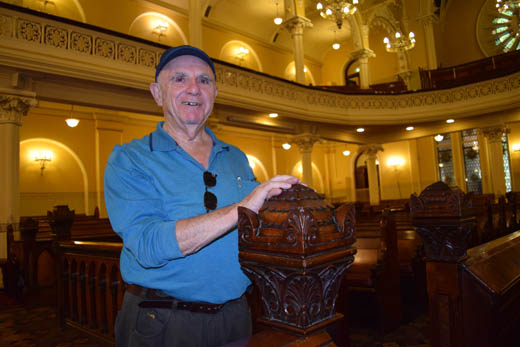
This is the first in a series of stories developed by editor Donald H. Harrison during his January 1-March 1 hiatus in which he collected stories in ports and at sea aboard the MS Maasdam on a cruise from Sydney, Australia, back to San Diego. Articles in this series normally will run on Thursdays and will deal with places and people he met along the way, both Jewish and non-Jewish.
By Donald H. Harrison

SYDNEY, Australia – In this city’s Great Synagogue, Joe Kensell, a longtime congregant, man of the sea, and tour guide, has great stories to tell. His great-great grandfather, Moses Joseph, was the founder of the predecessor synagogue, which was located on York Street. There, he and Kensell’s great-great grandmother, Rosetta Nathan, were the first Jews in Australia to be married in a Jewish ceremony. Oh, other Jews had been married in Australia, but their ceremonies were conducted by an Anglican minister—as no Jewish clergy had been present in Australia up to the Joseph-Nathan marriage in 1831. Prior to the nuptials, Peter J. Cohen was given permission by the Chief Rabbi in London, England, to conduct weddings and funerals in the British colony. Like other Jewish clergy who would come to Australia, Cohen didn’t call himself “Rabbi,” but rather “Reverend,” because, according to Kensell, the Chief Rabbi in London reserved the title of “Rabbi” for himself.
Moses Joseph was a convict, sent to Australia in 1828 in lieu of serving a sentence in a foul London prison for a non-violent crime. Back in England, Rosetta loved Moses notwithstanding his dishonor, and came to Australia as a free woman to marry him. There was a time when people like Kensell might have shied away from admitting that their ancestors were criminals, but over the years attitudes have changed. With the influx of Jewish immigrants from Russia during the late 19th century, and from other parts of Europe after World Wars I and II, those Jews whose families have been in Australia for the better part of two centuries take pride in their family’s longevity, even if their beginnings were disreputable. Kensell likes to tease tourists who ask him about his convict ancestry, one time rolling down his tight socks for a particularly persistent woman and showing the rings they had left near his ankles. Dead-pan, he told her that marks from the chains in which convicts were shackled were passed down from generation to generation. The lady believed him.
In actuality, Australian convicts who arrived in advance of the Free Settlers were not chained up, Kensell said. They needed freedom of movement to clear the brush and to build housing. Besides, they were not likely to run off into the bush, where Aborigines might attack them with either of two clever weapons of their design: boomerangs and throwing sticks, both of which they had invented.
Eventually Moses Joseph made his way into polite society. After working as a servant for the importers Cooper and Levey, he became in his own right one of Australia’s biggest gold buyers after that precious metal was discovered in New South Wales. The Australian gold rush preceded the California gold rush, the latter of which Joseph was quick to capitalize upon. According to his great-great grandson, “He very quickly realized that it was faster and easier to ship stuff from Sydney to California than from the East Coast of the United States, from which goods had to go around the bottom of South America before arriving in the Pacific Ocean. He had a number of small ships, so he started shipping to California. As a result of his experience in New South Wales, he knew what was wanted: picks, shovels, wheel barrows, metal plates, metal cups, and that is what they shipped.”
Becoming quite wealthy in the process, Moses Joseph was able to obtain a full pardon – Kensell speculating that his great-great grandfather may have shared some of the gold he acquired with an official or two to improve his status. He had enough money to buy the land on which the York Street Synagogue was built. He served as president of that synagogue, which at one point suffered the establishment of a breakaway congregation in a dispute over whether the child of a mixed marriage should receive synagogue rites. As Kensell tells the story, the congregation refused to bar mitzvah a boy who had a non-Jewish mother. In another source, Jewish Sydney: The First Hundred Years: 1788-1888, author Helen Bersten says a circumcision was at issue. The second synagogue was known as the MacQuarie Street Synagogue, and it rivaled the York Street Synagogue from 1859 to 1872. Finally, a new rabbi, Rev. A.B. Davis, persuaded the two sides to come together, sell their respective properties, and build the Great Synagogue.
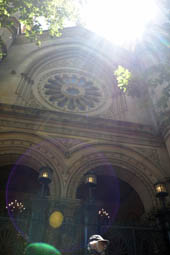
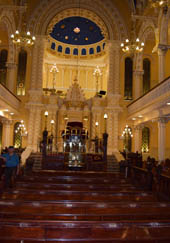
Thomas Rowe, a Scottish architect, was selected to design the Orthodox synagogue. “The synagogue dimensions, with the known engineering of the day, was as long and wide as it is without having to put extra pillars in the middle,” Kensell said. Approximately 600 men can be seated at ground level and another 600 in the ladies gallery upstairs, he said.
“The synagogue was consecrated March 4, 1878, so this year is 140 years,” Kensell noted. “The timber is mahogany and cedar, from the Hunter Valley, and the Huon Pine comes from near Hobart, Tasmania. The tiles came from Mother England.”
Conversion of gas lamps to electrical lights, and vibrations from buses that would one day regularly pass by the synagogue were problems that architect Rowe had not envisioned. “When electricity came in the 1900s, they electrified the synagogue by passing the wires down the gas pipes,” Kensell said. “Three years ago, somebody discovered that all of the fittings had been polished with a mercury compound, and mercury is known to give off a carcinogenic gas, so the federal government paid for them to be taken down one at a time, and put into an acid bath that had a fume hood and clean them up that way.”
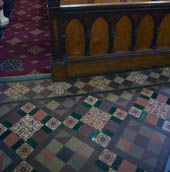
The vibrations from the buses caused the tiles on the floor to lift, posing a danger of tripping, especially for women in high heels. “The heritage architect found that the company in England that had supplied the tiles still existed, so he wrote to them, and as only an English company could do, they said, ‘Oh, that was a recent order; we can replicate it.’ One of the problems was the green tiles—it was discovered that the ultraviolet light of Australia discolored the green tiles, so they put a special glaze on them, and said it would take a number of years to wear off. Although they replicated the tiles, the color is slightly different. Also, the tiles came in standard depth, and the tiler had to grind down the backs to match the original tile, so people would not trip over them.”
The distance from those tiles to the highest ceiling is 32 meters. The synagogue is configured with a holy ark and reader’s table located in an arena, around which there is seating on three sides. Upstairs there is a choir loft, where at one time the sopranos and altos sat in front and the tenors sat behind. “Back in those days, quite a few Orthodox synagogues around the world had mixed choirs; it wasn’t until the chief rabbi in London in 1970 came out with a ruling that changed it,” said Kensell. “The point was that you could have male and female singers, but they couldn’t sing side by side; you had to separate them as we do with the men downstairs and the women upstairs. So, the great Synagogue like most of the others changed to an all-male choir.”
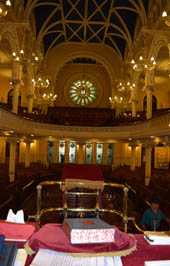
Kensell recalled that on one occasion, however, “We had a baroque concert here, and part of it required a soprano. What was done, the males sang from the choir loft, the lady sang in the female gallery, and that was acceptable to the rabbi because while they were performing together, they weren’t singing together. The same type of thing occurred in 2015 when we had a celebration here of ANZAC Day—the centenary of Galipoli—and it was set up for the service to be here. The prime minister, the governor general, and everyone else came. The problem was that the military wanted to sound The Last Post (Taps), but the practice was no musical instruments in the synagogue during a service. The rabbi came up with an answer; this is actually two buildings; the synagogue building and the office building, which front on different streets. There are fire doors between this building and the other one. So, they had a bugler at the top of the stairs, outside the main gallery, but you could hear it, even though you couldn’t see the bugler. And then there was a minute of silence.”
If some of these decisions seem like matters of fine points of law, well, it doesn’t hurt that the current president of the congregation is Stephen Rothman, who is a member of the Supreme Court of New South Wales.
The weather in Australia can get quite hot, and at one ceremony at the synagogue honoring judges, who wear robes and wigs, the question came up whether they also needed to wear kippot? Was a wig not a head covering? The matter was debated, and the court’s own practice provided the answer to this question. Before Australia abolished the death penalty, judges who were about to pronounce the death sentence wore black caps atop their wigs. Since those caps were head coverings for another, grimmer occasion, it was decided that head coverings also would be needed for the festive occasion in the synagogue. So, the judges just had to sweat.
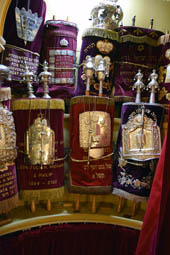
Every synagogue develops its own set of customs, and the Great Synagogue in Sydney is no exception. When calling up people for an aliyah, that is, the blessings before and after reading sections of the Torah, the Great Synagogue makes certain not to have members of the same family at the reader’s table at the same time. That custom was developed to guard against complaints of favoritism, Kensell said. During a bar mitzvah, the aliyot are arranged in such a way that a father and a son, or brothers, are called at different times, so they are not standing together.
The prayer for the Royal Family (of England), the prayer for the congregation, and the rabbi’s sermon are in English; the rest of the service is in Hebrew. Women are called up to open and close the Holy Ark, and to read the English prayer for the congregation. When more than one Sefrei Torah is taken from the Ark, one is taken upstairs to the women’s gallery, where it is taken around by one of the women. This was controversial, prompting one male member to withdraw from the sanctuary and stand outside whenever this ceremony is in progress.
Kensell, who has been a sailor, a chandler, and the officer of a shipping company who deals with the technicalities of hiring and deploying stevedores, noted that there is a box in which the congregation’s president, or vice president, sit, and an opposite one, in which another vice president sits. The latter’s duty is to get up every few minutes and post the number of the page in the siddur that the congregation is reading.
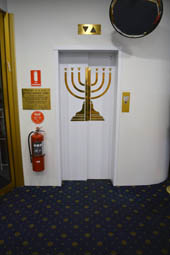
The British crown appoints representatives to both the national government of Australia and to the various state governments. The former is the governor general, the latter are governors. In New South Wales, one governor was Dame Marie Bashir, who is of Lebanese extraction. When she was growing up in Sydney, she was far too brilliant for an ordinary public school, so was sent to an exclusive private school, where she often was snubbed by students of Anglo ancestry. The Jewish students, however, befriended her – which she never forgot, according to Kensell. She spent many Friday nights having Shabbos dinner at Jewish homes. After her appointment as governor, a tea was held in her honor. To some, she was “Your Ladyship,” but such formalities were hardly necessary when she was with old Jewish friends. According to Kensell, she would go around the room exclaiming to friends, “so, how are your grandkids,” and etcetera.
On one occasion when Kensell was ushering for High Holy Days, Dame Bashir showed up and he assumed he should escort her to some seat of honor. “Oh no,” she waved him off. She had bought her own ticket, and was perfectly content to sit with her friends in the women’s gallery.
Another famous visitor was the singer Neil Diamond, who “everyone recognized, but who everyone ignored,” Kensell said. Congregants realized that he wanted to pray, not to be fussed over, or asked to sing an impromptu version of Kol Nidre, as he did in the remake of the movie The Jazz Singer. Kensell said Diamond was so relieved at being treated exactly like any other Jewish worshipper, that he returned the following week.
###
Pingback: Unsavory guests at Australia’s Hydro Majestic | San Diego Jewish World
Pingback: Australian rabbi grew up in secular Los Angeles home | San Diego Jewish World
Interesting story, very well written. Enjoyed it very much.